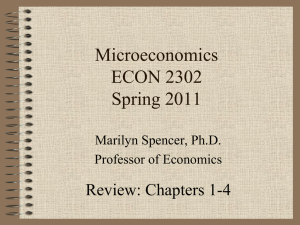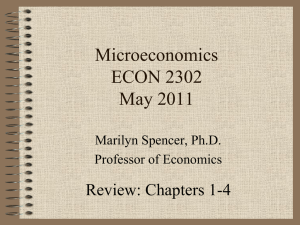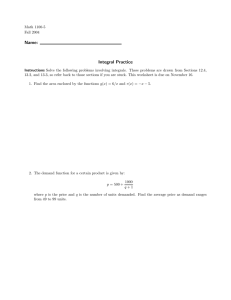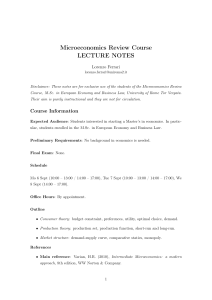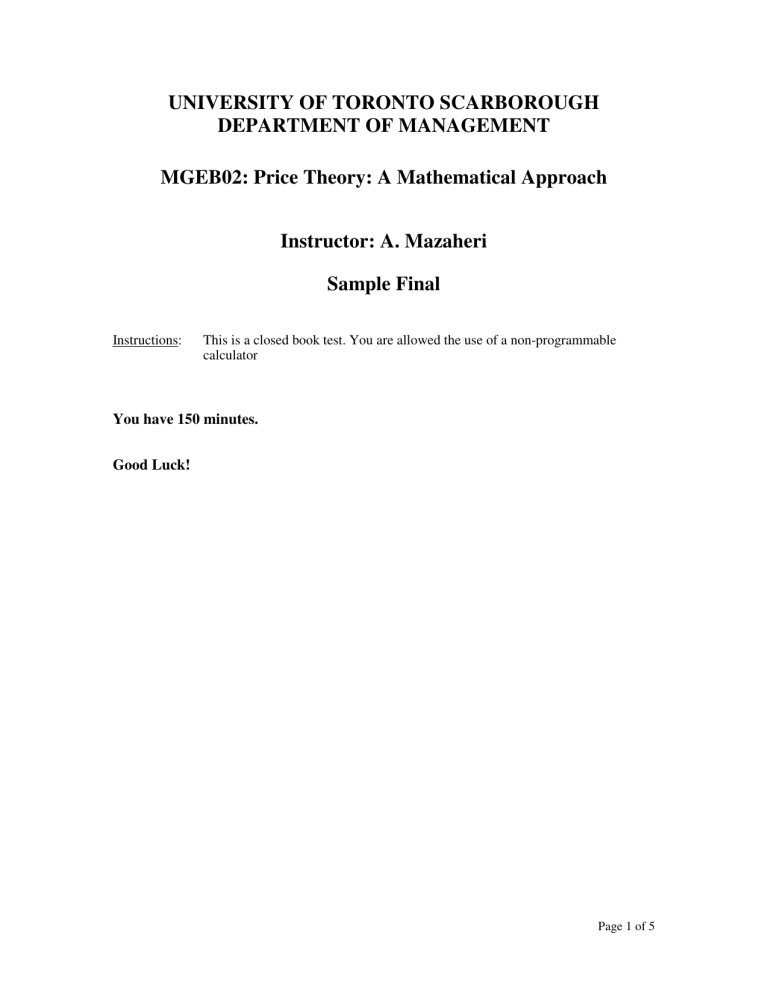
UNIVERSITY OF TORONTO SCARBOROUGH
DEPARTMENT OF MANAGEMENT
MGEB02: Price Theory: A Mathematical Approach
Instructor: A. Mazaheri
Sample Final
Instructions:
This is a closed book test. You are allowed the use of a non-programmable
calculator
You have 150 minutes.
Good Luck!
Page 1 of 5
Answer all following 6 questions in the Exam Paper:
Question-1 [35 Points] Answer the following short questions.
a) (8 Points) A consumer is considering choosing a calling plan for her cell phone. The
plan has a fixed monthly fee of $40, and it gives 200 free minutes per month and charges
$0.1 for each additional minute. The consumer has a monthly income of $100, and she
spend it on cell phone and another composite good y, where py =$1. Her utility function
y
is given by U ( x, y ) = x + , where x is the minutes of cell phone she uses in a month.
2
Find her optimal consumption bundle. Graph your solution on a diagram – including the
budget line and a representative indifference curve.
b) (8 Points) In a perfectly competitive market, there are 100 firm split equally between
the following short run cost functions:
C1 (q 1 ) = 2q 12 + 10q 1 + 200
C 2 (q 2 ) = 0.5q 22 + 10q 2 + 50
Find the total short run market supply curve and graph it.
c) (6 Points) Explain why a monopolist will never produce in the inelastic portion of its
demand curve, (say the demand of; P = 10 – 2Q.) Draw a properly-labeled graph to
support your argument.
d) (7 Points – a bit challanging) A consumer spends all of his income on x and y. Last
year, he consumed 20 units of x at a price of $50 per unit, and 50 units of y at price $40
per unit. This year, he got some good news and some bad news. The bad news was that
the price of y had risen to $50 per unit. The good news was that the price of x has
declined to $25 per unit. Using budget constraints and indifference curves, show that the
consumer's utility can be increased following these changes.
e) (6 Points – More changing) A food coupon program requires families to pay a certain
amount for food coupons. Suppose all families can receive $150 in food coupons for a
payment of $50 (call this policy A). Also, assume all households have $250 of income
and the price of food is $1 per unit. With the composite consumption good (CCG) on the
y-axis and food on the x-axis, draw the original budget line and the budget line under this
policy.
Compared with an allocated grant of $100 in food coupons (call this policy B), would
policy A lead to more, less, or the same food consumption? Why? Assume well-behaved
indifference curves.
Page 2 of 5
Question-2 [15 Points]: A consumer who derives his utility from two goods is
characterized by the following utility function
U(x,y)= min{2x, 5y}
Suppose that the consumer is endowed with an income of 100 (I = 100), and that px = 10
and py = 5.
a) (6 Points) Analytically derive this consumer optimal consumption point. Depict the
budget line and optimal consumption point in a well-labeled diagram.
Now suppose the price of declines to 5 (px = 5).
b) (4 Points) Derive analytically and show on the same diagram this consumer new
optimal consumption point.
c) (5 Points) Decompose the change in x consumption into a substitution and an income
effect.
Question-3 [10 Points]: Adam & Eve own separate farms. Depending on the market
conditions Adam has $10,000 profits and Eve only $900 or Eve has $10,000 profits and
Adam only $900. The probability of each state is 50%. Their satisfaction is characterized
by:
U= I
Adam & Eve think they should work together and merge their farms. If they were to
merge their farms, both would get half of the combined profits.
a) (6 Points) Do you think it is a good idea to merge? Use a graph to illustrate your
answer.
b) (4 Points) It turns out that because of all the lawyers involved, a merger is quite costly.
What is the maximum sum either one is willing to pay in lawyer fees?
Page 3 of 5
Question-4 [15 Points]: The market demand and supply functions for cotton are:
Qd = 10 - 4P
Qs = 6P + 5
a) (5 Points) Calculate the consumer surplus and producer surplus and show it on a graph
b) (5 Points) To assist cotton farmers, the government initiates a subsidy of $0.10 per
unit. Calculate the new level of consumer surplus and producer surplus.
c) (5 Points) Show that the combined increase in consumer and producer surplus is less
than the increased government spending necessary to finance the subsidy. Demonstrate
your answer in your graph for part (a).
Question-5 [15 Points]: The market demand is given as:
Qd = 1000 – 40P
[
]
2
The producers are characterized by q = L0.5 + K 0.5 . The cost of labor is $4 per hour and
the cost of capital is $1 per unit. In the short run the capital is fixed at 16 units.
a) (5 Points) Find the short run market supply curve. (Make sure to identify the short run
shut-down price).
b) (5 Points) Find the long-run supply curve? Identify the equilibrium quantity and price?
How many firms will be operating in the long run? Use a graph to demonstrate your
solution.
c) (5 Points) Suppose in addition to the firms identified above (parts a & b) there is a
single firm with a production function characterized by: q = 8 L0.5 K 0.5 . Find the long-run
supply curve for this firm. Explain briefly how the industry adjusts to the emergence of
this firm in the long run?
Question-6 [10 Points]: A monopolist has two factories for which costs are given by:
The firm faces the following demand curve:
P = 700 - 5Q
where Q is total output, i.e. Q = Q1 + Q2.
Page 4 of 5
a) [6 Points] Calculate the values of Q1, Q2, Q, and P that maximize profit.
b) [4 Points] On a diagram, draw the marginal cost curves for the two factories, the
average and marginal revenue curves, and the total marginal cost curve (i.e., the marginal
cost of producing Q = Q1 + Q2). Indicate the profit-maximizing output for each factory,
total output, and price.
Page 5 of 5




